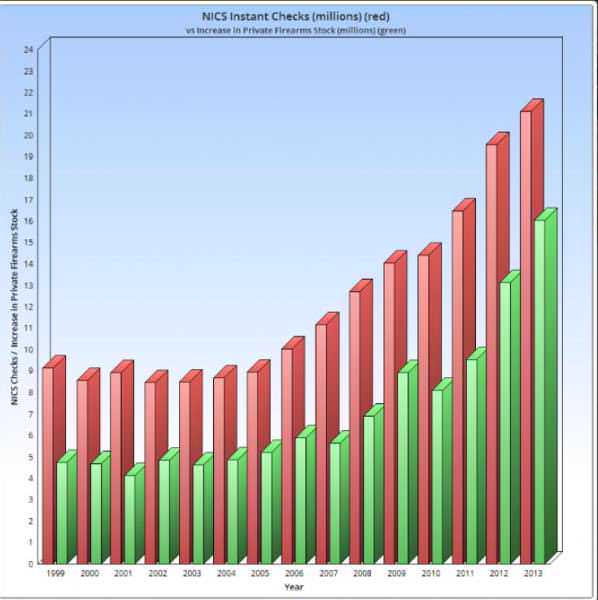By Dean Weingarten


Arizona – -(Ammoland.com)- The numbers are in from the Bureau of Alcohol, Tobacco, Firearms and Explosives, or ATF as the shortened acronym.
The report is issued annually for two years back. In 2014, there were 9,050,626 firearms manufactured; 3,625,268 firearms imported; and 420,932 firearms exported.
This includes rifles, shotguns, handguns and others, the others being mostly receivers that might become either rifles or handguns when finished. It does not include firearms produced for the military services.
The total addition to the firearms stock for 2014 was (production + imports – exports). That total is 12,254,962 firearms in 2014, which brings the total U.S. cumulative stock to over 375 million firearms at the end of the year. It is a bit less than what I had projected a year ago. The NICS checks for 2014 were similar in number to 2013, but the ratio of those checks used to procure new firearms compared to the total was a little less than the average over the last 15 years. In 2013, the ratio was a bit above the average.
The number of NICS checks for 2014 was 20.969 million, slightly lower than in 2013, which was 21.094 million (rounded to the nearest thousand).
Many NICS checks are used to purchase firearms that are already in the private stock; a fair number are used for background checks on carry permits; and more that one firearm may be purchased with a single background check.
The delay in the release of the production numbers by the ATF is not bureaucratic inefficiency. It is required by law. From the 2016 ATF report:
All federally licensed manufacturers of firearms and destructive devices (Federal Firearms License types 07 and 10) are required to submit a production report of manufacturing and export activity to ATF by April 1 of each year. The information must be reported using the Annual Firearms Manufacturing and Exportation Report Under 18 U.S.C. Chapter 44, Firearms (ATF Form 5300.11). The report covers activity for the calendar year ended the previous December 31. For example, calendar year 2009 data was due to ATF by April 1, 2010.
ATF compiles the submitted data and releases it here each January, with a one year delay to comply with the Trade Secrets Act. For example, data released in January 2013 was for calendar year 2011. The January 2014 data release will cover calendar year 2012 activity. In response to requests from the industry, ATF released interim AFMER data for the first time in July 2010. This release included aggregate data only and did not identify any specific industry member (to comply with the Trade Secrets Act).
The delay in the release of the data is to protect proprietary information that may be included in the reported numbers. It is not hard to see that knowing precisely how many .380 pistols, for example, were sold by a manufacturer, could be used to competitive advantage.
2015 was a record year for NICS checks, at 23,141,970. It will take another year before we find out if the number of firearms added to the private stock exceeded the record set in 2013, of 16.031 million.
I expect that another 13.422 million will have been added in 2015, but it could be as high as 17.588 million, based on the 2013 ratio of NICS checks to firearms added.
©2016 by Dean Weingarten: Permission to share is granted when this notice is included. Link to Gun Watch
About Dean Weingarten;
Dean Weingarten has been a peace officer, a military officer, was on the University of Wisconsin Pistol Team for four years, and was first certified to teach firearms safety in 1973. He taught the Arizona concealed carry course for fifteen years until the goal of constitutional carry was attained. He has degrees in meteorology and mining engineering, and recently retired from the Department of Defense after a 30 year career in Army Research, Development, Testing, and Evaluation.
